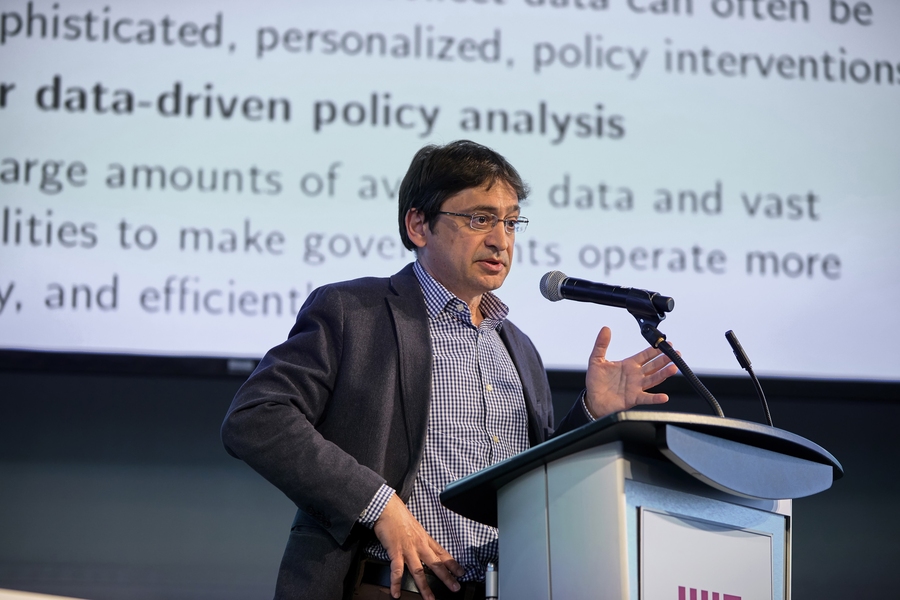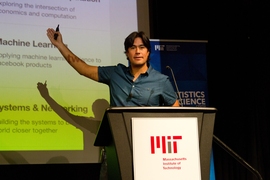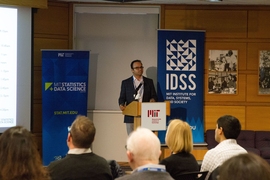As a focal point for statistics at MIT, the Statistics and Data Science Center (SDSC) reflects the unique nature of statistics at MIT: steeped in cutting-edge computation, with both theoretical explorations and novel applications across departments and domains. As part of the Institute for Data, Systems, and Society (IDSS), the SDSC also fosters multi-disciplinary collaborations that bring new approaches to complex societal challenges.
These themes — computation, cross-disciplinary collaboration, creative problem-solving — were all on display at the SDSC’s third annual SDSCon, a celebration of the statistics and data science community at MIT and beyond.
SDSCon brought together over 200 participants from academia and industry, with talks ranging from tactics and techniques like machine learning to statistical applications in biology and business. “The purpose of SDSCon is to bring together folks ... interested in statistics and data science, to both celebrate as well as build community,” said SDSC director and professor of electrical engineering and computer science (EECS) Devavrat Shah in his opening remarks. School of Engineering Dean Anantha Chandrakasan commented on the work the SDSC has done in building that community by “coalescing a community of scholars across campus around the shared mission to use statistical tools to advance research and education.”
“I feel somewhat like an interloper because I am not a statistician,” joked Esther Duflo in a plenary talk that highlighted how statistical methods are being used in new cross-disciplinary ways to address societal challenges. Duflo is the Abdul Latif Jameel Professor of Poverty Alleviation and Development Economics at MIT. Her research uses machine learning to analyze the results of randomized control trials. Combined with data collection and the leveraging of social networks, she seeks to raise the number of children in developing countries who receive crucial, life-saving immunizations.
A panel of talks exploring statistics in the social sciences addressed other key societal challenges. Alberto Abadie, an MIT professor of economics and associate director of IDSS, discussed how data science is driving changes in social science research and policy making. Stanford University’s Ashish Goel looked at tools for public decision making, while Aaron Roth of the University of Pennsylvania explored how social values and ethics can be better embedded into algorithms that make autonomous decisions.
Members of the community of scholars employing advanced statistics tools at MIT gave presentations on their work, ranging from mechanical engineering and IDSS Professor Anette “Peko” Hosoi’s investigation of luck versus skill in fantasy sports, to biology professor and SDSC affiliate Aviv Regev’s design for better experiments in solving large scale challenges in cellular biology. Nike Sun, an MIT math professor, described progress toward a solution in a theoretical geometric problem in classic probability called the Ising perceptron, while John Tsitsiklis, an EECS professor who directs MIT’s Laboratory for Information and Decision Systems, gave a plenary talk focused on gaps between theory and practice in a kind of machine learning known as reinforcement learning.
SDSCon also featured talks from data science practitioners in industry. Dawn Woodard, an adjunct professor at Cornell University who is also director of data science for maps at Uber, demonstrated methods for dynamic pricing and matching in ride hailing. Lester Mackey, an adjunct professor at Stanford and statistical machine learning researcher for Microsoft Research, discussed how machine learning tools are being used to improve weather and climate forecasting that is "subseasonal," a time period from two to six weeks in the future where precipitation prediction can have a big impact on water management.
The Statistics and Data Science Center, along with IDSS, will join the new MIT Stephen A. Schwarzman College of Computing in the fall. The new college, like IDSS, crosses all five schools at MIT, and should serve as a fitting home for what Chandrakasan called the “deep interdisciplinary nature of statistics and data science.”
Said Chandrakasan: “I commend SDSC for providing a shared space among disciplines, and shaping the practice of statistics at MIT in a manner that focuses on multi-disciplinary collaborations that examine some of the most complex societal challenges we face today.”








